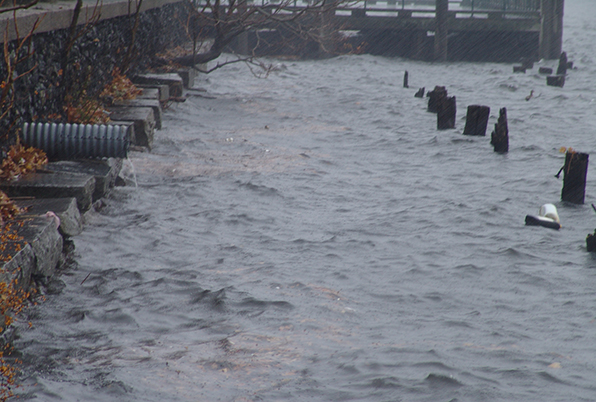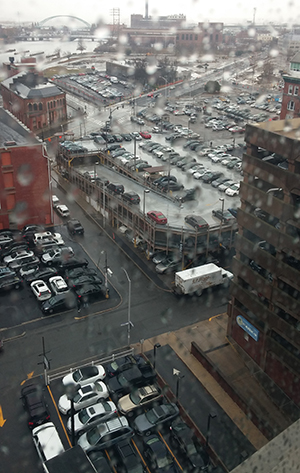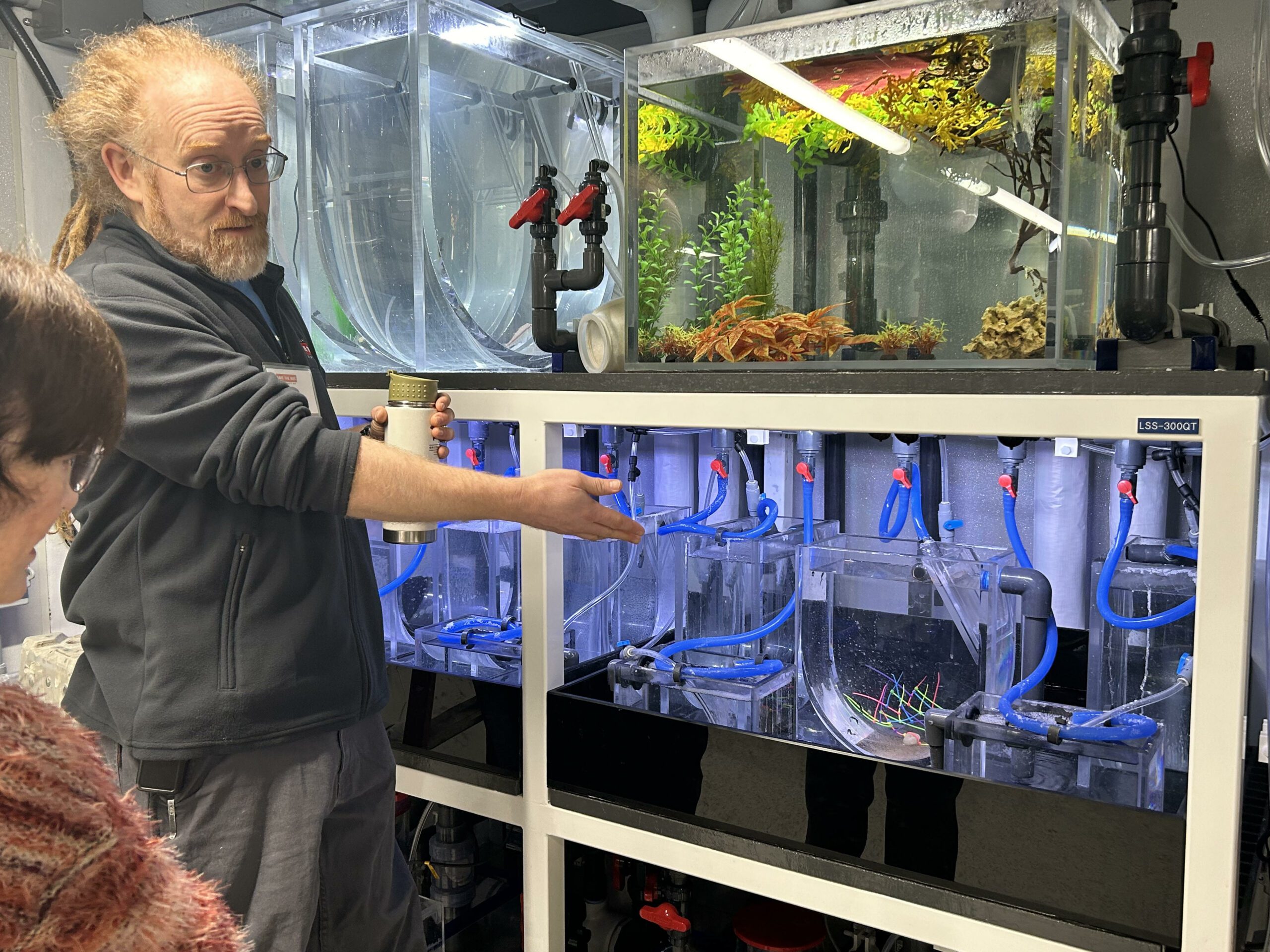December 1, 2014
Narragansett Bay’s 700 billion gallons of water cover 150 square miles, and its watershed nurtures thousands of species of plants and wildlife in both Rhode Island and Massachusetts. This indispensable watershed supports more than 2 million people, and attracts some 12 million tourists annually. Some 300,000 professionals and amateurs fish its waters every year, and more than 30,000 recreational boaters annually explore the bay and its many tributaries.

Several estimates have suggested that the total value of the natural resources of the Narragansett Bay watershed exceeds several billion dollars annually.
Yet, stormwater rushing off the many acres of impervious surface that covers much of the watershed sends bacteria, nutrients and other contaminants into the region’s signature resource. Beaches are closed, toxic algae blooms, and money is lost.
Roughly 14 percent of the Narragansett Bay watershed is under streets, roofs, driveways and parking lots. Within Rhode Island, impervious cover by municipality ranges from 3 percent to 40 percent. When impervious cover is between 10 percent and 25 percent, nearby streams show clear signs of degradation. When such cover is less than 10 percent, streams support a wide range of life. Only 17 municipalities in the state feature less than 10 percent impervious cover.
In Massachusetts, from 1999 to 2005, land was developed at a rate of 22 acres daily, converting 40,000 acres of forest and farmland to residential use. Not surprisingly, since 2001, flooding has caused about $260 million in property damage in Massachusetts, according to the Hazards and Vulnerability Research Institute.
Each state is dealing with this runoff problem in both expensive and commonsense ways, but lost among the Narragansett Bay Commission’s successful combined sewer overflow project and the continuous promotion of rain gardens and rain barrels are two ideas that have received far less attention — stormwater utility districts and parking taxes.
A stormwater utility district, an idea first introduced in the United States in the mid-1970s, is essentially a tax designed to generate funding for stormwater management. Some 2,000 U.S. municipalities employee such districts, according to the Environmental Protection Agency (EPA). Users within a district pay a fee, and the revenue generated supports such efforts as maintenance and upgrade of existing storm-drain systems, flood-control measures and water-quality programs.
In 2006, Newton, Mass., established a stormwater fee that enables the city to manage and upgrade stormwater infrastructure, and protect Crystal Lake and the Charles River. User fees are based on a flat rate; residential properties are assessed a fee of $6.25 a quarter, and all other properties are assessed $37.50 a quarter. The city’s stormwater fee generates about $600,000 annually.
Newton offers abatements against this fee for customers who undertake specific actions to reduce the impact of runoff, such as rain barrels and rain gardens.
In fact, Massachusetts has two companion pieces of legislation that allow cities and towns to set up stormwater utilities, and several municipalities besides Newton, such as Duxbury, Marshfield, Chicopee, Salem, Plymouth and Reading, have discussed or adopted the use of such a district.
Reading’s stormwater utility district, also implemented in 2006, generates about $430,000 annually, charging single- and two-family residences $10 a quarter, and multifamily, commercial and industrial properties $40. The town of nearly 24,000 has three major water bodies — the Ipswich and Aberjona rivers and Bear Meadow Brook.
In Rhode Island, Providence, Bristol and Middletown have studied the idea of taxing asphalt and other impervious surfaces. The Rhode Island Stormwater Management and Utility District Act of 2002 authorizes municipalities to create stormwater management districts, “to eliminate and prevent the contamination of the state’s waters and to operate and maintain existing stormwater conveyance systems.”
Even though many face costly infrastructure projects and no money to fund them, no Rhode Island city or town has adopted a stormwater utility district.
Proponents of the idea believe Providence is the ideal municipality to implement Rhode Island’s first. The city has 16,000 catch basins, 400 miles of sewers, 20,000 manholes and 175 outflows. When it rains, the city is violating environmental laws as stormwater floods streets, sewer pipes and Narragansett Bay.
Providence has explored the idea of creating a regional stormwater utility district with other municipalities, such as Pawtucket, Johnston and North Providence, that also regularly violate environmental law during heavy rains.
Proponents of such a fee system say stormwater utility districts are more equitable than continually relying on higher property taxes.
Unlike, say, these recent ideas that, given Rhode Island’s dismal track record, would most assuredly saddle local taxpayers with a greater financial burden: Gov.-elect Gina Raimondo wants to give away some of the Interstate 195 land for the development of a Rhode Island Innovation Institute; a Providence City Council member introduces an ordinance that would create a blanket tax-stabilization agreement for all of the I-195 parcels and remove the mayor and the City Council from the decision-making process.
Both of those ideas focus on the false panacea of economic growth, and fail to consider the impact on the environment and local taxpayers.
Stormwater utility districts, on the other hand, help address climate change and shift the tax burden away from homeowners. In fact, Middletown likes the concept because a stormwater utility district is similar to an enterprise fund. Like the town’s sewer system, trash collection and beach operations, a stormwater utility district could be fully funded through fees rather than the general fund, which relies on property taxes.

Parking tax
Proponents of parking taxes — an idea that has been largely overlooked in southern New England — say such a fee structure actually lowers property taxes.
They also claim a parking tax incentivizes other forms of transportation and ride sharing, and the revenue it generates can be used to reduce other taxes.
In Philadelphia, a parking tax is imposed on every person parking or storing a motor vehicle in or on a parking facility in the city.
On the other side of Pennsylvania, policies enacted by the city of Pittsburgh have helped discourage solo car commuting. The city issues a 40 percent tax on parking throughout the city — the highest tax of its kind in the country. The tax reportedly generates about $44 million annually.
The city of San Francisco imposes a 25 percent tax on all commercial off-street, non-residential parking transactions. Revenues are divided between the city’s general revenue, public transportation and senior citizen funds.
Taxing parking can make downtowns livelier and encourage a healthier mix of transportation options, according to Providence resident James Kennedy, a vocal community activist on issues of transportation.
During a recent interview with ecoRI News, Kennedy noted that cities with less parking do better economically and environmentally. He said a parking tax is one of the most important economic development and transportation initiatives Providence could adopt.
“A parking tax can really help cities that are starved for money,” Kennedy said. “It lowers the tax burden that property owners unfairly shoulder. It requires visitors to the city to share a portion of the tax burden, unlike property and car taxes, which only impact residents.”
Christopher McCahill of the State Smart Transportation Initiative in Madison, Wis., spoke with Streetsblog earlier this year about the cost of parking. He began his research into how parking impacts small cities’ downtowns as a University of Connecticut Ph.D. student in 2006.
McCahill has studied Hartford in particular detail. He told Streetsblog that despite a 27 percent increase in downtown development, high-rises packed the resulting development onto 13 percent less land, opening up 120 acres for surface parking — enough to pave over Disney’s Magic Kingdom.
Much of this parking supply, he said, is for state offices, noting that the city and state also built a lot of expensive parking structures, which eviscerated downtown.
Proponents of a parking tax, such as Kennedy, claim such a tax would work better than a gas tax, because drivers who shun the parking tax by driving less would leave lot owners with less revenue, not transit agencies such as the Rhode Island Public Transit Authority.
They also claim a parking tax would favor smaller businesses that often struggle to compete with big-box stores.
“We don’t want to tax the crap out of businesses,” Kennedy said, “so taxing parking creates a fair way to increase revenues without placing all of the burden on local taxpayers.”
Parking taxes also would help alleviate traffic congestion and address the problems associated with polluted runoff from asphalted lots that ultimately gets flushed into Narragansett Bay.
Categories
Join the Discussion
View CommentsRecent Comments
Leave a Reply
Your support keeps our reporters on the environmental beat.
Reader support is at the core of our nonprofit news model. Together, we can keep the environment in the headlines.
We use cookies to improve your experience and deliver personalized content. View Cookie Settings




In addition to all the good ideas in the post, there is also a social justice issue. Providence metro area homeowners and tenants have seen massive Bay Commission rate increases in recent years to pay for the tunnels, but the benefit is largely to more affluent Bayside communities, whose residents, by using the metro area roads and parking lots (such as around the State House, at medical facilites etc) contribute to the runoff problerm but don't have to pay for the cleanup.